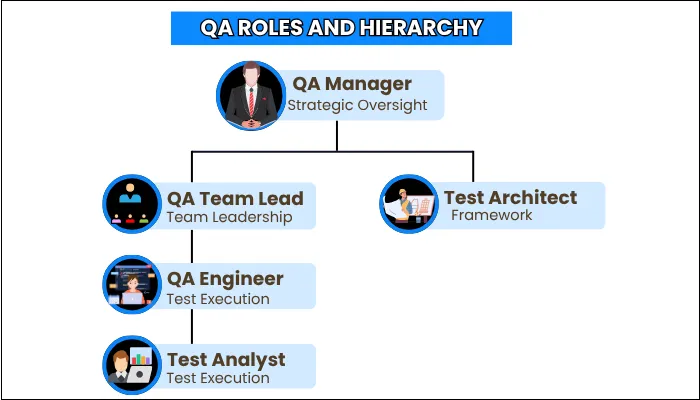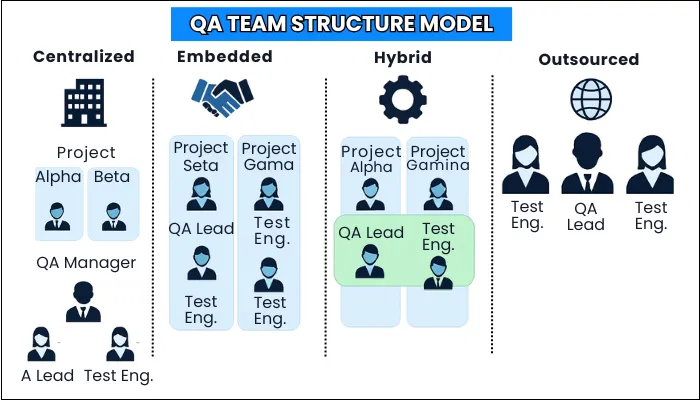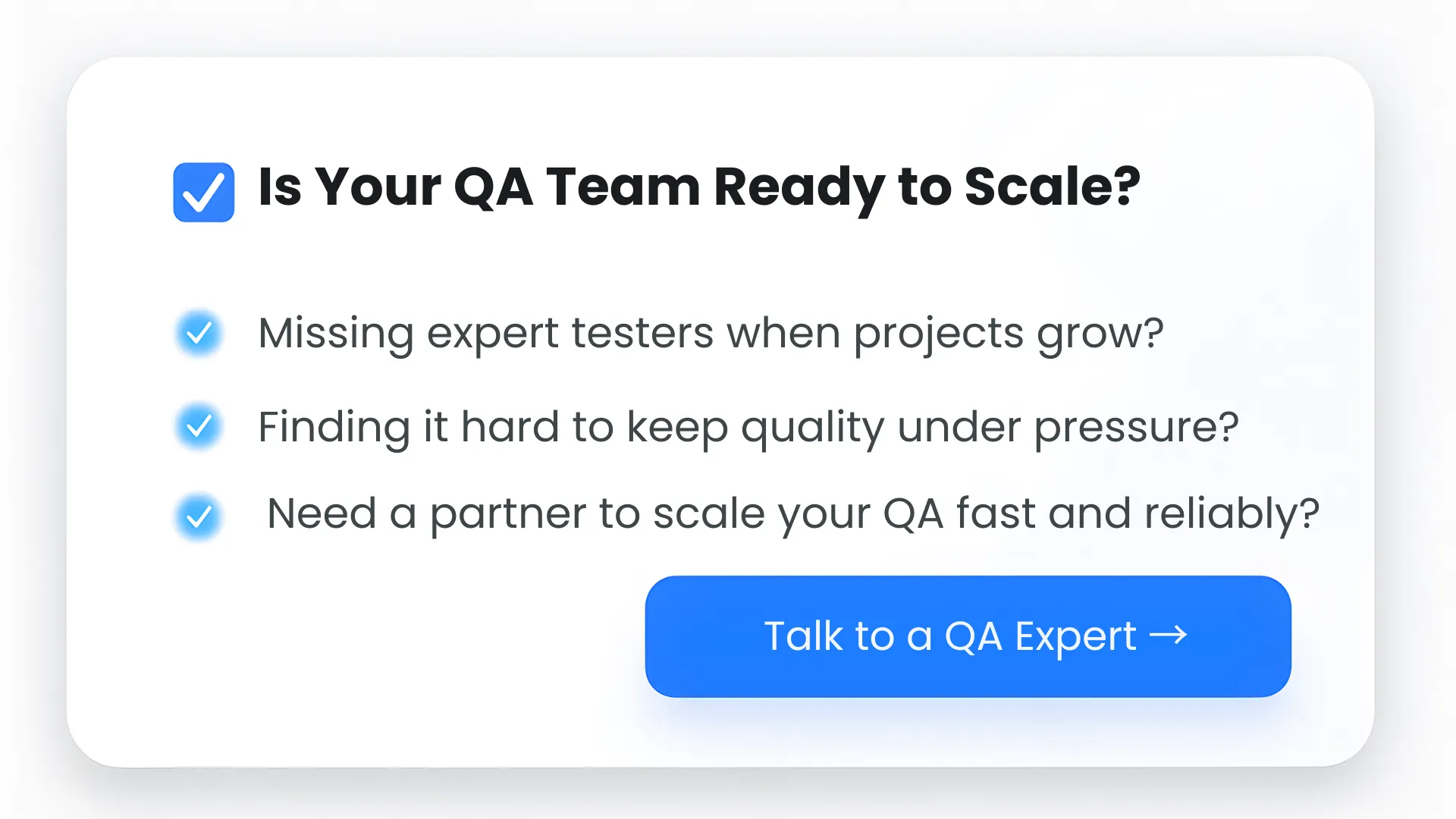How to Build an Effective QA Team for Enterprise Software
There is a huge change happening in software quality assurance (SQA). What was once considered reactive, the last step in the development process, has now become a strategic and essential business imperative.
Undeniably, the quality of an enterprise software is directly related to the financial health and brand reputation.
To keep organizations safe from expensive mistakes and develop long-lasting relationships with customers, a proactive SQA approach is now essential.
An error in consumer software might not hurt the business very much, but that's not the case with enterprise software. A flaw in an enterprise system can stop payroll processing, interrupt supply chain operations, put sensitive customer data at risk, or lead to compliance fines of millions of dollars.
IBM’s Cost of Data Breach 2024 report revealed that the average global cost of a data breach reached a record high of $4.88 million.

A knowledgeable and effective QA team is the most effective way to ensure that your enterprise software works flawlessly.
This article provides further detail on the skills and duties required of an effective QA team, including how to set up teams for growth, build one from scratch, and address the problems businesses will encounter along the way.
Skills Necessary for an Enterprise Software QA Team
To find every nook and cranny in the enterprise software, a strong QA team needs a set of specific talents. Your short-listed team should have a mix of technical and collaborative abilities.
They should also ensure that large-scale systems operate consistently and securely across various settings. In other words, the team should excel in both technical and soft abilities. With that in mind, here are the qualities you should look for when putting up your QA team:
1. Technical Skills
Each member should possess relevant technical skills, enabling them to contribute effectively towards finding and fixing bugs. The top technical skills that you should be looking for include:
- Proficiency in Manual Testing: In the present time of automation testing, manual testing is a skill often overlooked. The talent you seek should be proficient in performing various types of manual testing efficiently, including integration, regression, sanity, security, smoke, stress, load, and non-functional testing.
- Automation Testing Expertise: In addition to manual testing, the team should be skilled in automation testing and building, maintaining, and scaling automation frameworks tailored to enterprise software. From designing reusable scripts to integration automation into CI/CD pipelines, your team should be capable of doing it all.
- Understanding of Databases and Backend Systems: Enterprise software processes massive volumes of structured as well as unstructured data. Your QA team should be comfortable in writing SQL queries, validating data integrity across distributed systems, and checking for issues such as duplication, loss, or unauthorized exposure. For instance, validating an ERP or CRM system requires testing workflows at the database layer to ensure transaction accuracy across modules.
- Tool and Framework Adaptability: It's clear that enterprise initiatives involve several departments, products, functions, and locations; thus, one tool can't meet all the needs. Because of this, you should look for team members who are flexible and can quickly adapt to new frameworks.
- AI Proficiency: The present time is all about artificial intelligence. To stay ahead of the competition, you need to hire QA professionals who are skilled in leveraging AI in QA testing. Whether it's prompt engineering or using AI-based testing tools, they should know the technical know-how of all.
2. Soft Skills
Unlike hard skills, which involve specific, technical expertise, soft skills focus on qualities like emotional intelligence, adaptability, teamwork, and effective communication, helping individuals perform well in social and professional situations.
- Analytical Thinking: As enterprise software is linked together, a problem in one module might affect several business operations. With strong analytical skills, QA specialists can identify the fundamental causes of problems, predict potential dangers, and develop tests that delve deeper into the program.
- Communication: QA teams are considered the bridge between developers, business stakeholders, compliance officers, and end-users.
They should write clear defect reports that developers can resolve quickly, and present test metrics in a way that executives understand. And, all that is possible when they have excellent communication skills, allowing them to convey the information effectively. - Risk Awareness and Prioritization: Not every defect in software is equally important. A typo on a dashboard is a minor error, but a bug in the financial reporting module may cost millions in lost business and compliance fines. A bug found and fixed in production can be up to 100 times more expensive than if it were found during the design phase.
Your QA team should be able to recognize and prioritize risks, allowing them to focus their efforts on the areas where failure would have the most effect. - Continuous Learning: To achieve long-term success, QA teams must remain adaptable by adopting new tools, learning new domains, and shifting between automation and exploratory testing as needed. The idea of constant improvement ensures that QA remains a value generator for the business.
Must Read: A complete guide to enteprise software testing
Key Roles in an Enterprise Team
Testing enterprise software is highly complex. To manage this complexity, QA teams should be built with defined roles that ensure technical skills and strategic oversight. Let’s understand the essential roles that shape an effective enterprise QA function.

- QA Manager: Handling the entire team, the QA Manager is responsible for the outcome produced by QA. They are not just overseeing test execution, but building the entire quality idea for the organization.
QA managers have to set up processes, manage budgets, allocate resources, and ensure that QA objectives align with business priorities. In addition, they are responsible for building and nurturing the tea, often across distributed locations, while maintaining reporting that executives can trust.
Apart from their skills, they bring over a decade of QA experience with strong leadership, negotiation, and decision-making skills. - QA Team Lead: Working closely under the QA Manager is the QA Team Lead, who takes responsibility for the tactical side of delivery. Once the QA Manager defines the goals, the QA Lead focuses on how the execution will take place. In enterprise software, they ensure that cross-team dependencies are managed smoothly.
Their ability to manage people while staying hands-on with test execution makes them an essential bridge between strategy and operations. - Test Architect: Enterprise apps require resilient, reusable, scalable, and modular frameworks, especially when systems integrate with multiple APIs and microservices.
Considered as the technical brain of the QA function, the Test Architect designs and maintains the required frameworks, shortlists the right tools, and sets the best practices for automation and test coverage.
Unlike a QA Lead, who focuses on team management, Test Architects are deeply technical, often with backgrounds in development, automation, and DevOps. Typically, Test Architects have 8–12 years of hands-on QA experience, often with backgrounds in development or system architecture. - QA Engineer: QA Engineers perform test execution, design test cases, build automation scripts, and log defects, among other testing tasks. They are also the ones closest to the software, identifying usability gaps or overlooked risks that might otherwise go undetected.
QA Engineers need proficiency in manual and automation testing, knowledge of SQL and APIs, and familiarity with enterprise test management tools. Most QA Engineers have 2–5 years of experience, making them the workhorses of the QA function. - Test Analyst: Enterprise software testing is conducted to ensure the program's stability and bug-free operation, enabling the organization to increase its user base, enhance user experience, and ultimately achieve higher profits. And for that, you also need to look at QA from a business perspective.
Test Analysts bring this perspective into the QA process, where their responsibility is to translate business requirements into testable scenarios, validate workflows, and ensure testing aligns with real-world enterprise use cases. In addition to 3-6 years of experience, Test Analysts need strong analytical skills, domain expertise, and a deep understanding of requirement gathering and mapping.
Structure of a QA Team
How a QA team is structured can significantly impact the quality, speed, and cost-effectiveness of enterprise software delivery. The structure determines how QA professionals interact with development teams, business stakeholders, and external partners. Below are the most common QA team structures adopted in enterprises:

- Centralized Model: In the centralized model, all QA resources and processes are consolidated into one dedicated department that serves multiple projects across the enterprise. Enterprises often juggle multiple large-scale applications. A centralized QA team prevents repetition of effort and maintains consistent testing quality across systems.
The centralized model is best suited for organizations with complex portfolios, multiple stakeholders, and the need for uniform quality practices. - Embedded Model: In the embedded model, QA professionals are integrated directly within development teams. Here, testers work closely with developers, business analysts, and product owners from the very beginning of the development lifecycle so that issues are caught earlier, reducing costly fixes in later stages. Embedded testers focus on test planning, execution, and automation aligned with sprint goals.
- Hybrid Model: The hybrid model combines the elements of centralized and embedded structures, where they maintain a central QA function to define strategies, tools, and governance while also embedding testers within development teams for day-to-day execution. Here, the central unit handles high-level functions like test strategy, governance, and audit compliance, while embedded testers ensure early defect detection and faster delivery.
- Outsource QA: Instead of handling or hiring a dedicated in-house QA team, the QA responsibilities are partially or fully outsourced to third-party service providers. It's great for quick scalability, reducing costs, or accessing niche testing expertise as outsourcing brings access to specialized tools, domain experts, and cost efficiencies. This model is suitable for software that requires rapid scalability, lacks internal expertise in areas such as security or performance testing, or seeks to reduce costs.
The Role of T-Shaped Skills in QA Team Structures
No matter which model an organization prefers to implement, the effectiveness of QA in enterprise software relies on individual team members' skills. With that in mind, it’s crucial to consider the T-Shaped Skills model.
In a T-shaped skills model, testers are skilled in one particular area, but have a good understanding of other related areas as well. In this model, there are two bars: a vertical and a horizontal.
- Vertical Bar: Here, every tester has a core specialization such as performance engineering, compliance testing, automation, or security validation.
- Horizontal Bar: At the same time, testers need a working knowledge of adjacent areas. An automation engineer should also understand APIs and CI/CD pipelines; a compliance tester should be able to work with functional teams to validate workflows.
Building a Reliable QA Team for Enterprise Software
To build a reliable QA team for enterprise software, you need to know the key roles, talents, and experience required, as well as how to structure their tasks to fit the needs of enterprise applications. Below is a detailed explanation of each key step and aspect:
- Appoint a QA Leader: The first and most essential step is to hire a QA Manager with 10-12 years of experience in QA roles and a minimum of 5 years in managing QA teams.
Furthermore, their expertise should cover an in-depth understanding of various testing methodologies, including functional, automated, security, compliance, and performance testing. - Understand Project and Organizational Needs: Once you have a dedicated QA leader, the next step is to engage with the project manager, product owners, and business stakeholders to understand the scope and complexity of the enterprise software. You need to analyze system architecture, dependencies, integrations, regulatory standards, deployment environments, and testing timelines.
Having a clear understanding of the requirements will allow you to shortlist team members based on the required skills and resources. - Hire Skilled Professionals: It may sound like an easy job. However, it’s not just complicated, but it also influences the future of your enterprise software QA.
When recruiting, prioritize candidates with a proven track record in enterprise or regulated environments. Though each candidate will bring something unique to the table, you need to be clear about what you’re looking for.
Essential technical skills include proficiency with automation tools such as Selenium, Appium, Cypress, JMeter, and Postman, programming capabilities for scripting test automation, experience with test management platforms like Jira or TestRail, and familiarity with CI/CD tools, including Jenkins and Azure DevOps. Additionally, testers with expertise in security, performance, and accessibility testing bring valuable diversity to the team.
To find the right candidates, you can use several job portals such as Indeed, Monster, LinkedIn, and Glassdoor. A referral scheme might also help you get your current employees to bring in new talent. - Develop a QA Test Strategy: A robust test strategy will be your outline of the scope of functional testing across integrated systems, the extent of automation, and the inclusion of non-functional testing. In addition, you need to address test data management and environment provisioning, which can be challenging in enterprise software due to the multiplicity of platforms and external dependencies.
Here, you can also choose the right tools, which are critical to support complex testing needs.
The following are the top tools for the desired action:- Test Management: TestRail, Tricentis qTest, and Zephyr Enterprise.
- Functional and Regression Automation: Selenium, Cypress, Tricentis Tosca, and Telerik Test Studio.
- Performance & Load Testing: Apache JMeter, Tricentis NeoLoad, and BlazeMeter.
- Onboarding the QA Team: Now that everything is set, it's time to onboard the newly assembled QA team. Effective onboarding will introduce new QA members to enterprise-specific business goals, compliance rules, testing frameworks, tools, and workflows. It's crucial to clarify roles, responsibilities, communication methods, and quality metrics from the start.
Challenges in Assembling a QA Team
Building an effective QA team is a bumpy ride with several challenges waiting for you. These challenges can ruin all the efforts if you face them unprepared. With that in mind, the following are the key hurdles you’re likely to face while assembling your QA team.
- Finding Talent with Enterprise Domain Knowledge: A tester working on ERP finance modules must be familiar with accounting standards, whereas a QA analyst testing healthcare platforms needs to understand how HIPAA operates. In short, they need to have in-depth knowledge about the business as well as the technical side of things. Finding professionals who pair testing skills with deep domain knowledge is difficult, and training generalist testers can be time-consuming.
- High Demand for Advanced Technical Expertise: The current testing scenario encompasses more than just manual testing. The team must design automation frameworks, run performance tests, validate integration with third-party systems, and conduct penetration testing. The talent market for highly trained QA engineers is competitive due to rising demand, making hiring expensive and time-consuming.
- Retaining Skilled QA Professionals: Enterprise QA is a long-term endeavor that requires stability and extensive system understanding. However, skilled QA engineers often move into roles in automation development, product management, or DevOps, leading to high turnover.
The tech industry, in general, experiences one of the highest turnover rates, with an average of 13%, making it a constant challenge to maintain a consistent, experienced team.
- Location and Distributed Team Constraints: With remote working normalized, teams function across multiple locations for round-the-clock service. Hiring the right talent in specific geographies is another challenge, especially when local markets lack QA maturity. In addition, maintaining clear communication and collaboration is another tussle.
Upskilling Team the Right Way
There’s a fine line between an average QA team and an effective QA team for enterprise software. Though both can get the job done presently, the key difference can be noticed when the technology shifts. From subtle changes to significant technological changes, only the teams capable of upskilling can provide consistent results. Considering that fact, let’s understand the ways in which you can ensure that your team remains always on top of their game:
- Understand Skill Gaps: The first step of improvement is understanding where they lack. You need to identify where the team currently stands versus where they need to be. For that, you can conduct skill assessments, review past testing issues, and map them against upcoming project needs to attain a clear picture. Without this diagnosis, training efforts risk being generic rather than impactful.
- Align Learning with Career Growth: Upskilling should never feel like a chore. To ensure that never happens, you should align new skills with individual career goals. QA engineers aiming for leadership roles may focus on test strategy and stakeholder communication, while others may specialize in security testing. By linking training with career progression, you ensure higher employee retention.
- Build an Internal Learning Culture: Learning should begin internally and is considered among the fastest ways to bridge gaps. Make sure to motivate experienced QA engineers, architects, and leads to mentor their subordinates on enterprise challenges. And, don’t limit this knowledge sharing to technical skills, but focus on collaboration and team cohesion to actually build this culture for future growth.
- Leverage External Training and Certifications: There is no denying the fact that internal learning is practical, but it has certain limitations. External specialized training programs, certifications, workshops, hackathons, and seminars add rigor and expose teams to industry best practices, giving them valuable skills.
- Implement Continuous Tracking of Progress: One of the key parts of upskilling the team is tracking the process through measurable outcomes. Team leads can set up skill matrices, performance dashboards, goals, and quarterly reviews to monitor growth, ensuring accountability and highlighting effective learning efforts.
Build VS Buy VS Partner Enterprise QA Team
For enterprises, the final and most critical decision is how to acquire the necessary talent and expertise. The final choice directly impacts the speed and success of the transformation. You have three different approaches for the same: Build an in-house team, outsource the entire team, or use a hybrid approach with a mix of both.
| Factor | Build an In-House Team | Outsourcing | Hybrid Approach |
| Control | In-house teams offer full control but demand heavy leadership and governance. | There is less control, though vendors follow defined SLAs. | Shared control with strategic alignment, ensuring enterprise priorities are respected. |
| Customization | Customization is possible, but dependent on internal bandwidth and specialist availability. | Vendors adapt proven frameworks to enterprise needs. Customization is available but within limits. | You can co-create strategies tailored to your enterprise architecture and compliance needs with the partner. |
| Expertise | In-house expertise is limited by the resources that can be hired and retained. Specialized skills are hard to sustain. | It gives quick access to skilled testers in automation, security, and performance. | Partners bring deeper domain expertise and ensure continuous upskilling. |
| Scalability | In-house scaling takes time due to hiring and onboarding cycles. | These teams scale up or down quickly with project demand. | Partnerships scale flexibly while aligning with enterprise growth. |
| Cost | In-house teams carry high upfront and ongoing costs. | Outsourcing has predictable costs and low upfront investment. It delivers strong short-term ROI. | Partnerships share investments and deliver compounding ROI over the long run. |
| Best Fit For | Enterprises with large budgets, mature processes, and low urgency. | Enterprises needing speed, flexibility, and cost-effectiveness. Useful for large-scale or short-term needs. | Enterprises focused on long-term quality, innovation, and domain alignment. |
Conclusion
QA teams working on enterprise software are expected to ensure smooth functionality, security, compliance, and seamless user experience across interconnected systems. Now you understand the skills, structures, steps, and challenges that define effective QA teams, as well as the various models enterprises can adopt to build them.
The future of QA involves continuous transformation. AI and automation are expanding testing coverage while reducing manual effort and will continue to do so in the coming years. Apart from that, continuous testing will become the norm in DevOps pipelines, compliance will be integrated into test design from the start, and teams will increasingly be built around T-shaped skill sets.
However, the biggest challenge here is that most enterprises are not equipped to scale QA to this future on their own. Building and retaining teams with diverse expertise takes years, leaving enterprises vulnerable to slower releases and higher costs.
The best way forward is to connect with third-party providers. With a renowned name, you gain access to specialized skills, scalable teams, access to top tools, and domain expertise that can adapt as technology evolves. The future of QA is adaptive, intelligence-driven, and collaborative, and enterprises that embrace third-party partnerships will not only meet the demands of today but stay ready for tomorrow’s challenges as well.
High testing costs, missed release deadlines, and talent shortages hinder the progress of enterprise software projects. With QA testing services, ThinkSys solves these challenges with scalable, expert-driven QA outsourcing. Our teams bring the right blend of skills and expertise to ensure your software is tested thoroughly, efficiently, and cost-effectively for quick and stable releases.
Frequently Asked Questions
Share This Article:






